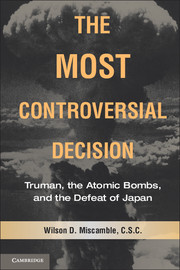Book contents
- Frontmatter
- Contents
- Acknowledgments
- Map 1 The Atomic Bombing of Japan
- Introduction: The Most Controversial Decision
- 1 Franklin Roosevelt, the Manhattan Project, and the Development of the Atomic Bomb
- 2 Harry Truman, Henry Stimson, and Atomic Briefings
- 3 James F. Byrnes, the Atomic Bomb, and the Pacific War
- 4 The Potsdam Conference, the Trinity Test, and Atomic Diplomacy
- 5 Hiroshima, the Japanese, and the Soviets
- 6 The Japanese Surrender
- 7 Necessary, But Was It Right?
- 8 Byrnes, the Soviets, and the American Atomic Monopoly
- 9 The Atomic Bomb and the Origins of the Cold War
- Suggested Readings
- Index
7 - Necessary, But Was It Right?
Published online by Cambridge University Press: 05 June 2012
- Frontmatter
- Contents
- Acknowledgments
- Map 1 The Atomic Bombing of Japan
- Introduction: The Most Controversial Decision
- 1 Franklin Roosevelt, the Manhattan Project, and the Development of the Atomic Bomb
- 2 Harry Truman, Henry Stimson, and Atomic Briefings
- 3 James F. Byrnes, the Atomic Bomb, and the Pacific War
- 4 The Potsdam Conference, the Trinity Test, and Atomic Diplomacy
- 5 Hiroshima, the Japanese, and the Soviets
- 6 The Japanese Surrender
- 7 Necessary, But Was It Right?
- 8 Byrnes, the Soviets, and the American Atomic Monopoly
- 9 The Atomic Bomb and the Origins of the Cold War
- Suggested Readings
- Index
Summary
In the nineteen fifties, General George C. Marshall, army chief of staff during World War II and the great “organizer of victory,” sat for a series of interviews with his biographer, Forrest C. Pogue. Asked about the necessity of dropping the atomic bombs, Marshall replied that “I think it was quite necessary to drop the bombs in order to shorten the war.” He explained that “what they [the Japanese] needed was shock action, and they got it. I think it was very wise to use it.” Marshall took no pleasure in their use but the distinguished soldier–statesman correctly understood that the two terrible weapons had forced the Japanese surrender when it occurred. By July of 1945 the Japanese had been subjected to months of devastating attacks by B-29s, their capital and other major cities had suffered extensive damage, and the home islands were subjected to a naval blockade that made food and fuel increasingly scarce. The Japanese military and civilian losses had reached approximately three million and there seemed no end in sight. Despite all this, however, Japan's leaders and especially its military clung to notions of Ketsu-Go, to a plan that involved inflicting such punishment on the invader in defense of the homeland that the invader would sue for terms. Even after Hiroshima, Nagasaki, and the Soviet attack in Manchuria the military still wanted to pursue that desperate option, but Hirohito broke the impasse in the Japanese government and ordered surrender.
- Type
- Chapter
- Information
- The Most Controversial DecisionTruman, the Atomic Bombs, and the Defeat of Japan, pp. 112 - 124Publisher: Cambridge University PressPrint publication year: 2011



